Features of wallpaper borders

Wallpaper borders are the finishing touch to wall decoration. From the material of this article you will learn how they look, what they are, where they can be located. In addition, we will tell you how to choose and apply them correctly.
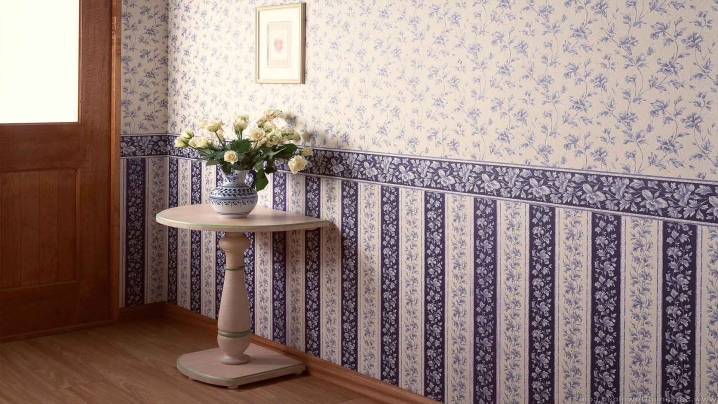
Description
Borders for wallpaper - decorative stripes of the same length glued to the edges of the wallpaper, providing for the combination of the pattern. Depending on the variety, they may differ in width, material of manufacture, release form and design.
Curb edges have 2 functions:
- make the wall decoration complete, changing its perception for the better;
- help to dock different wall coverings, making the transition between them.
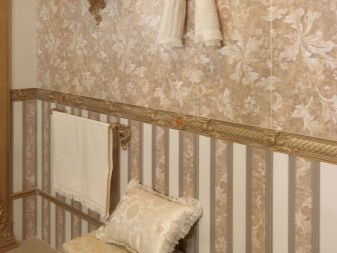
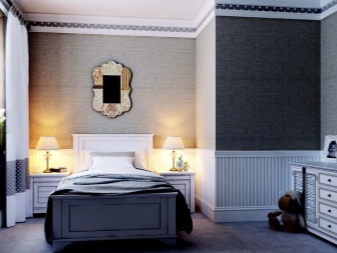
With the help of wallpaper borders, you can zone the space, introducing an unobtrusive organization into it and highlighting the significant details of the interior design. Curb edges are able to visually adjust the size of the interior space.
In addition to setting boundaries at the docking points, curbs are bought to hide finishing errors and accentuate ceilings.
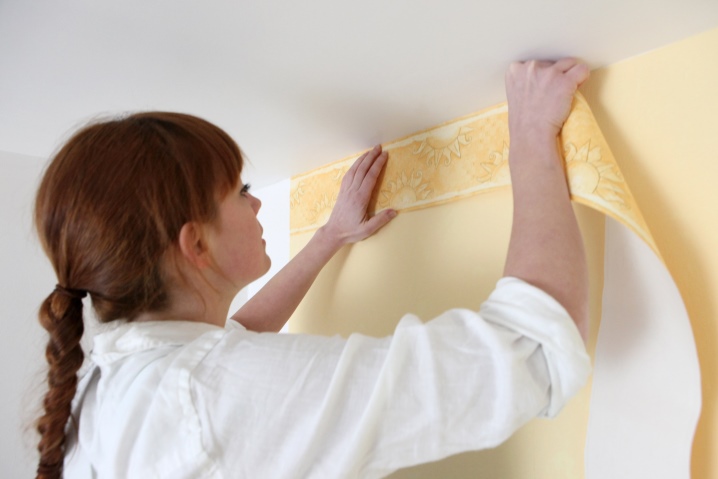
The decorative wall material may differ in the type of base. In the assortment of stores, it is presented in a wide variety. At the request of buyers, you can choose products from the same series to the existing wallpaper. In addition to the coincidence of colors, such borders also have the same pattern.
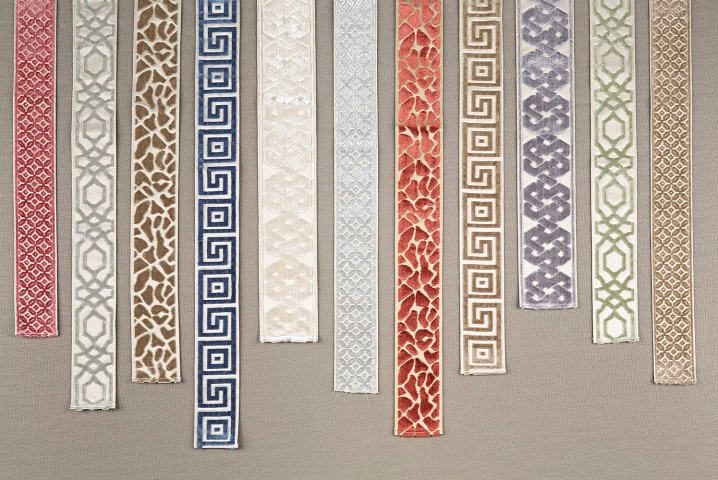
The border edging is very diverse. Stripes can be regular or curly. One edge is always straight, the second can be wavy or carved, symmetrical and asymmetrical. This allows the drawing to be played up. For example, the bottom edge can be cut to fit the leaves or scallops of the border design.
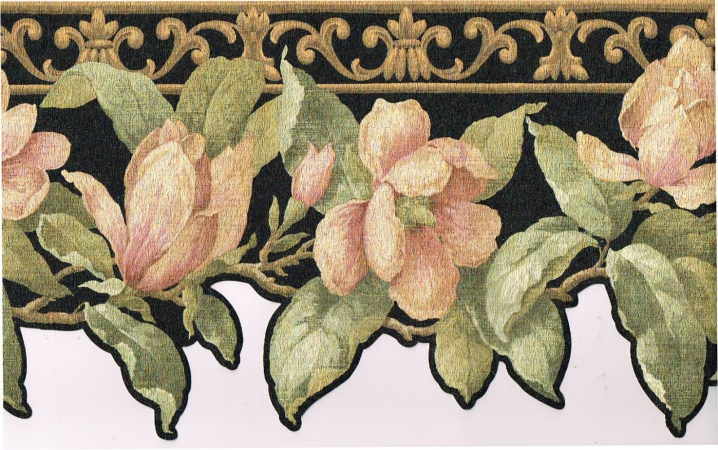
The color solutions of the decor are completely limitless. This allows you to choose wall decorations as closely as possible to the color of the wallpaper or other interior decoration. In addition to plain varieties without a pattern, you can find on sale options with a print for every taste. The subjects of the images are varied: from laconic floral motifs and geometry to elaborate stucco molding and images of heroes of children's cartoons.

The curb wall material is suitable for use in various residential rooms. Depending on the design, it is appropriate in halls, living rooms, bay windows, kitchens, dining rooms, offices, children's and playrooms. In addition, it can be made to decorate the hallway, highlighting the entrance area, emphasizing the wall panels.
This decor can also be used to decorate closed balconies and loggias.
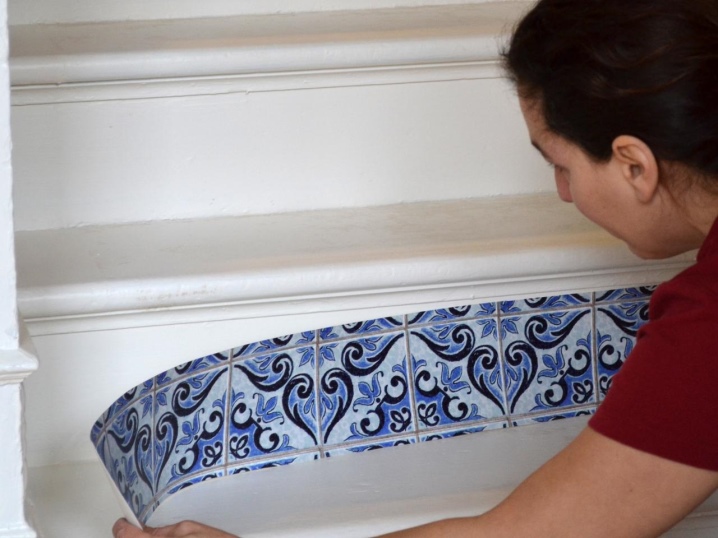
However, the quality of the material varies. Some types of wallpaper borders are very thin. Despite their elasticity, they can tear when glued, so you have to work with them as carefully as possible. In addition, during gluing, they may lie unevenly, or even form wrinkles altogether.
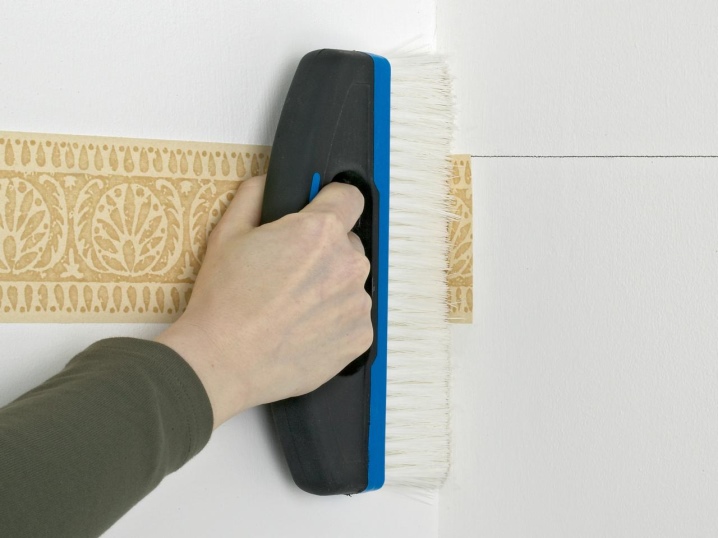
Species overview
You can classify wallpaper borders on several grounds.
- To size. Their width can vary from 1.5 cm to almost 1 m. In this case, the roll material is usually from 5 to 10 m in length. This is convenient for work and eliminates the need to adjust the pattern when edging the selected edge.
- By the method of attachment. Based on the basis of the material, the technology of its gluing differs. Some varieties need to be lubricated with glue, others should only be moistened, and others should be removed from the protective substrate.
- By texture. Today, in the lines of manufacturers there are not only the usual options with a smooth surface. The buyer can pick up embossed products, through which the interior can be refined.
- By the peculiarities of the color. In addition to ordinary borders, decorative ribbons with holographic patterns, gilding and perforation are produced today. The last two types require careful gluing. If you wish, you can also buy friezes that glow in the dark.
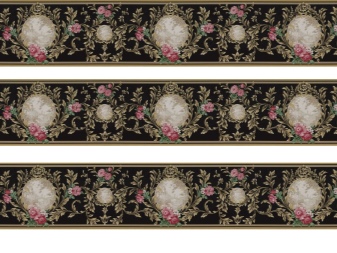
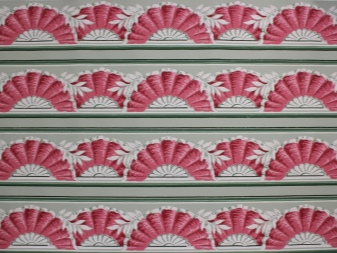
All types of produced border decor for wallpaper can be divided into several main groups according to the type of material used. Each of them has a number of its own characteristics, advantages and disadvantages.
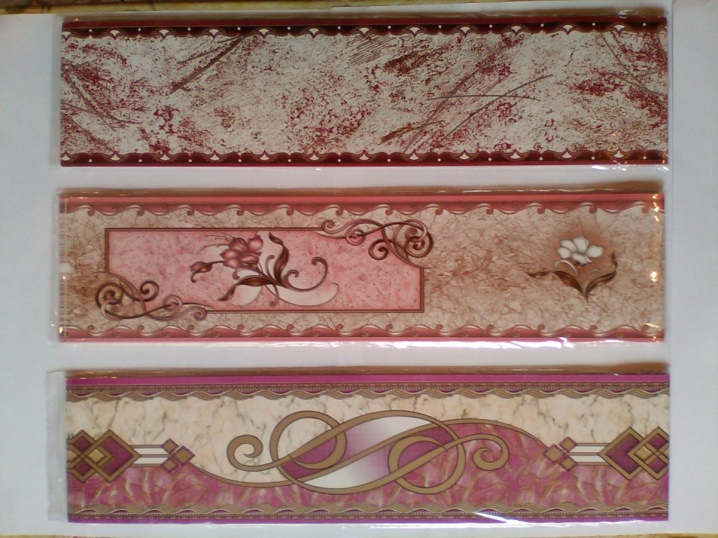
Paper
Products of the paper group are referred to as budget borders for wallpaper. They are easy to use and disassemble, but short-lived and do not require wet cleaning. These are products for gluing in living rooms, children's rooms and bedrooms. They are not suitable for decorating rooms with a high level of humidity.
In addition, they are not resistant to fading and wear off when wiped.
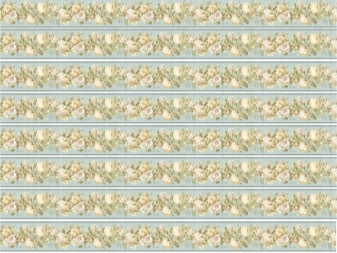
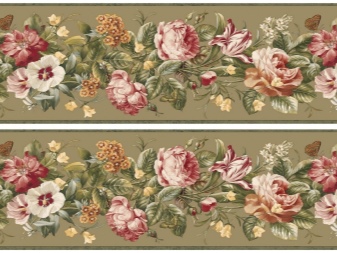
Vinyl
Vinyl (polyvinyl chloride) tapes with a non-woven base are more practical, stronger, more durable than paper counterparts, and are cheaper than non-woven friezes. They are resistant to fading, are not afraid of wet cleaning with the use of detergents, and are suitable for decorating rooms with increased pollution (hallways, kitchens, bathrooms). They are considered "breathable" finishing materials.
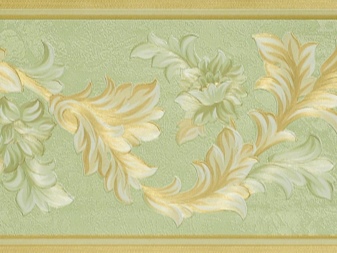
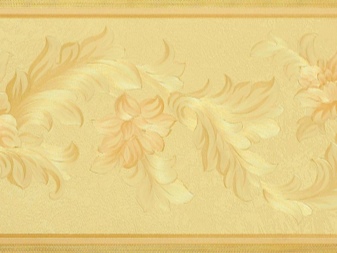
Non-woven
Stripes made of fabric non-woven material differ from vinyl counterparts in the upper decorative layer. The top layer of this coating is applied with a special roller. Depending on the variety, the non-woven piping can be painted. This opens up a lot of possibilities for decorating stripes yourself.
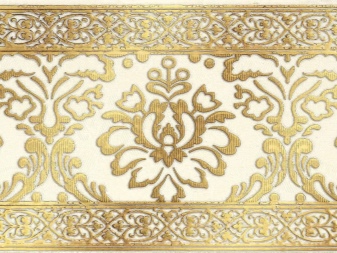
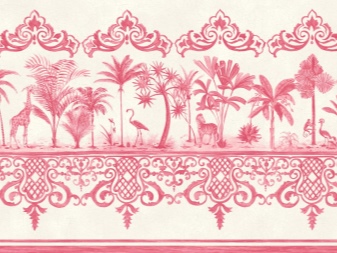
Acrylic
There is an acrylic emulsion on the surface of such tapes. Such a wallpaper edging has a lot of advantages, in terms of quality it is not inferior to vinyl and non-woven counterparts. It is strong, durable, suitable for any type of washable wallpaper. The disadvantage of such a frieze is the high price: the wider the strip, the more expensive it is. However, the price of acrylic edgebands is inferior to fiberglass edges.
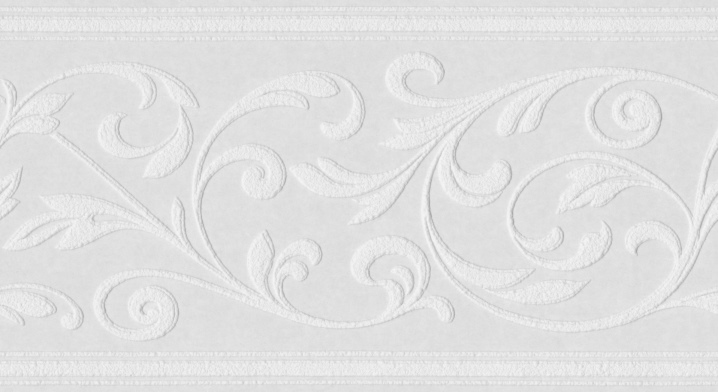
Textile
Woven stripes are bought for textile wallpaper. These tapes consist of 2 layers (paper and fabric), which achieves high strength and coating density. The woven layer is applied to a paper backing. Such edges are aesthetically pleasing and durable. With their help, you can bring to life the most unusual stylistic interior solution.
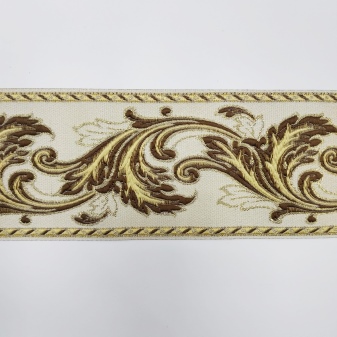
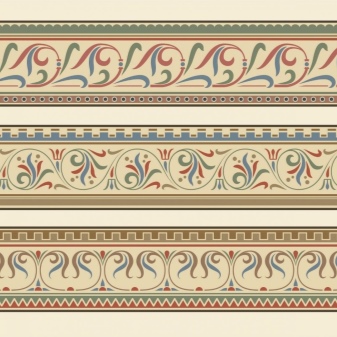
Other
In addition to the usual options, on sale there is a plastic, wooden, wall lace border for interior decoration, as well as modifications from foam and polyurethane. Each species has its own characteristics. For example, wooden edging is used to decorate the walls and ceilings of country houses or summer cottages. In city apartments, it does not look so appropriate.
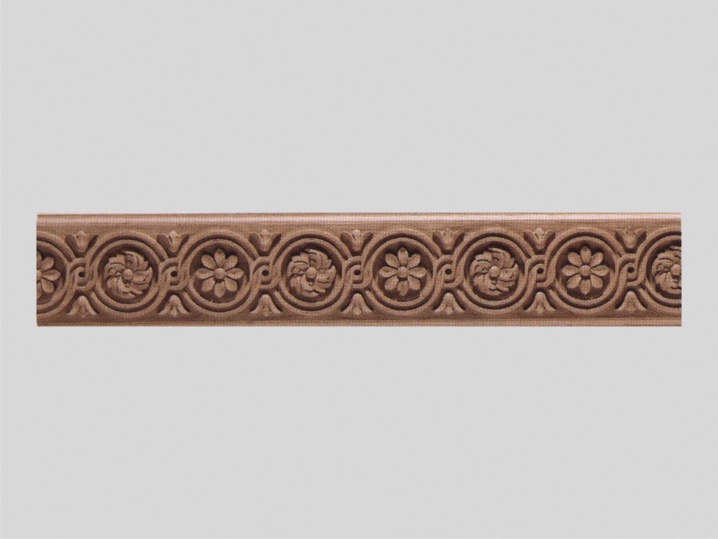
The plastic frieze is easy to clean (easy to clean) but difficult to attach to walls or ceilings. It is sold in strips of 1 and 2 m, which have to be cut during work. The advantage of this edging is the possibility of painting. Its base is flat and convex. Products of the first type are attached directly to the wall. Modifications of the second type are mounted simultaneously on the wall and ceiling.
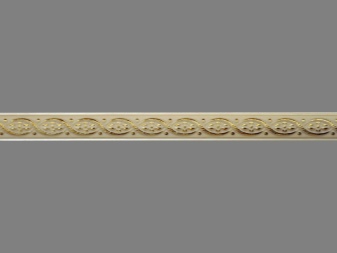
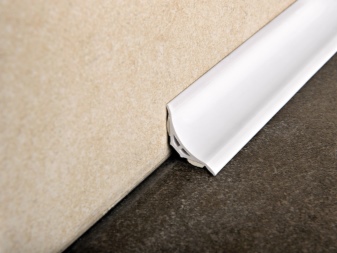
Ceramic edging is bought to accentuate areas of wet rooms (bathrooms, combined bathrooms and kitchens). For other premises, it is inappropriate. In addition, fiberglass varieties can be found commercially. They do not collect dust, are resistant to wet cleaning.
Their surface texture can be smooth or corrugated, with geometric patterns in the form of squares or rhombuses.

Among the large assortment of finishing edging come across velor borders. They are nylon fibers applied to a paper backing. These products are unusual, aesthetically pleasing, but not abrasion resistant.They also attract dust.
Self-adhesive borders are also an original solution. They differ in the width and adhesion of the base. You need to choose them thoroughly, since low-quality material can simply fall off the walls over time. You need to glue such a border in parts, gradually removing the substrate. Otherwise, the material will simply stick together, which will lead to its unusability.
It is expensive, it is glued 1 time without correction.
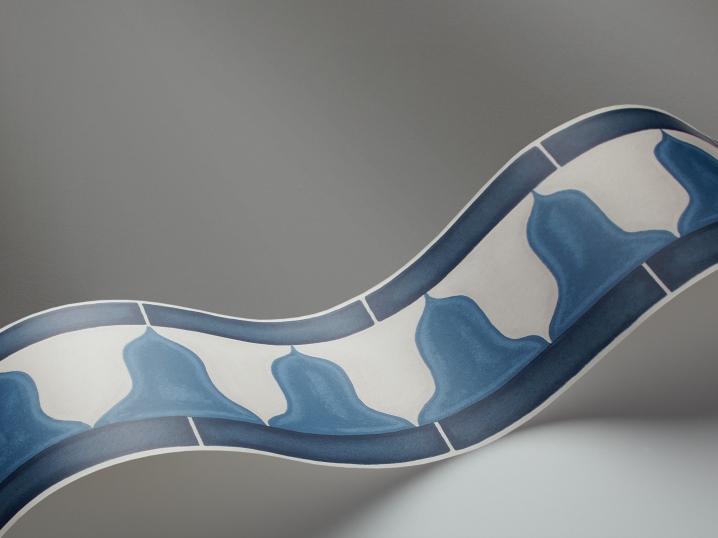
How to choose a wallpaper based on the design?
The choice of curb tapes must be approached thoroughly. They are bought taking into account the classification, which must be taken into account as a matter of priority. Each room has its own functionality, and therefore the decoration should be individual.
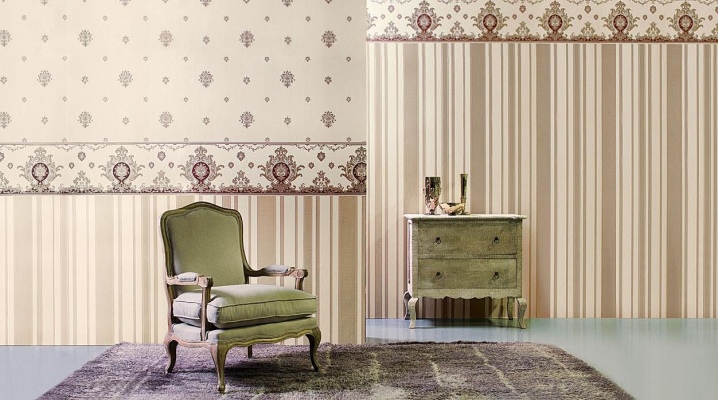
It is customary to select wallpaper stripes for walls or ceilings, taking into account the color or pattern combination. The interior should be kept in the same style, without a hint of aggressiveness and vulgarity.
You should refrain from choosing products in acid tones. Better to rely on slightly muted, noble shades.
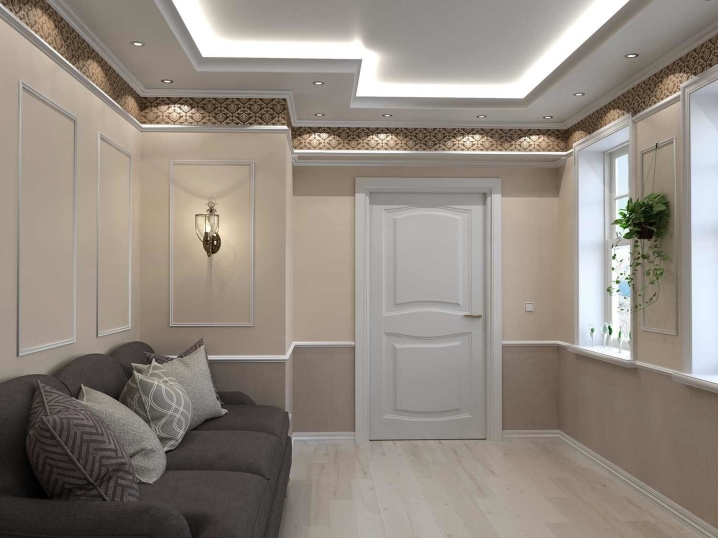
Bright and colorful ribbons are bought in those rooms where the stake is made specifically on the walls. These zones are not loaded with furniture at all. In order not to be mistaken with the choice of color, it is worth picking up the edging to match the wallpaper pattern. There is another win-win option: pick up the material to match the floor plinth.

The choice of width matters. Narrow wallpaper borders allow you to visually adjust the height of the wall slabs. If you glue bright, and even wide ribbons under the ceiling, you can visually shorten the height of the walls. With a low ceiling, it is worth gluing tapes no more than 3-4 cm wide.
If you need to beat the height of the walls, you should bet on the color. For example, white stripes will visually erase the border between the wall and the white ceiling. This will make the walls appear taller. At the same time, dark (for example, brown, burgundy) ribbons will only emphasize the limited space.
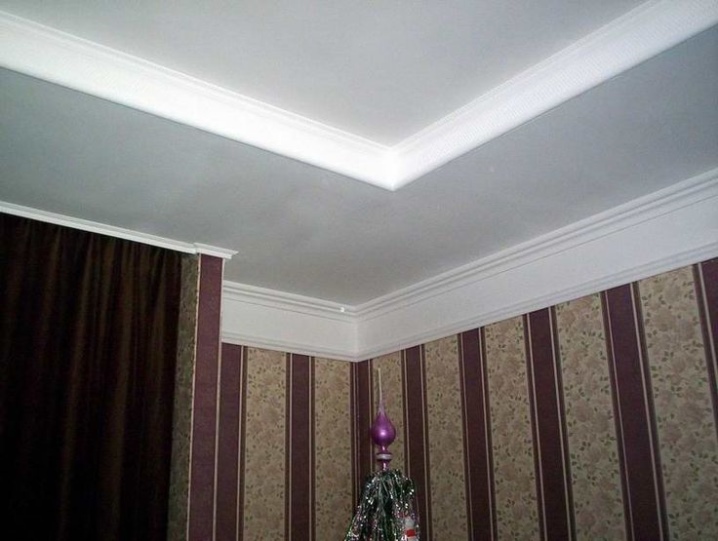
When choosing products with a pattern, it is worth considering the area of the room. In small rooms, you need to buy narrow varieties with a small and uncomplicated pattern. Solid edging can also be an excellent solution. The walls and ceilings of spacious rooms can be decorated with wide borders with a suitable theme of stylistic choice.
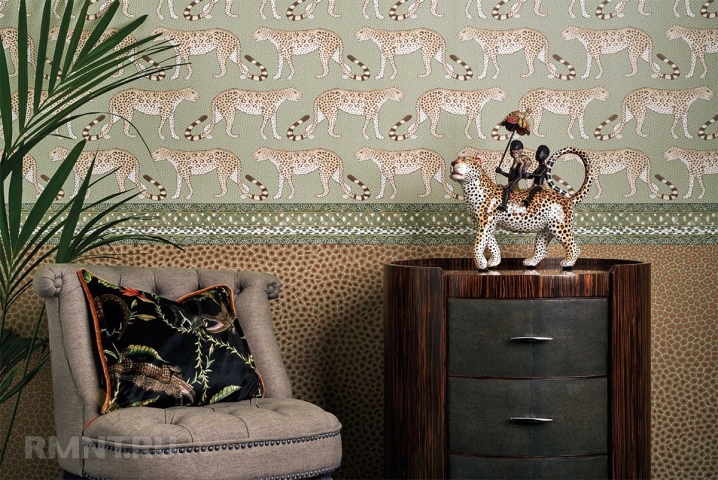
Today it is fashionable to select stripes in the same style as wallpaper. They have the same pattern as the wallpaper, but in a smaller format. This technique gives integrity and harmony to the design. Patterned borders are also suitable for plain wallpaper. In this case, they set the mood for the entire interior and do not overload the space.

For framing the premises, you need to buy the same materials. For paper wallpapers you need paper tapes, for vinyl you should choose vinyl friezes. Woven edging is bought for textile wallpaper.
Ignoring this rule affects not only the durability of the cladding and decoration, but the aesthetics suffer from this.
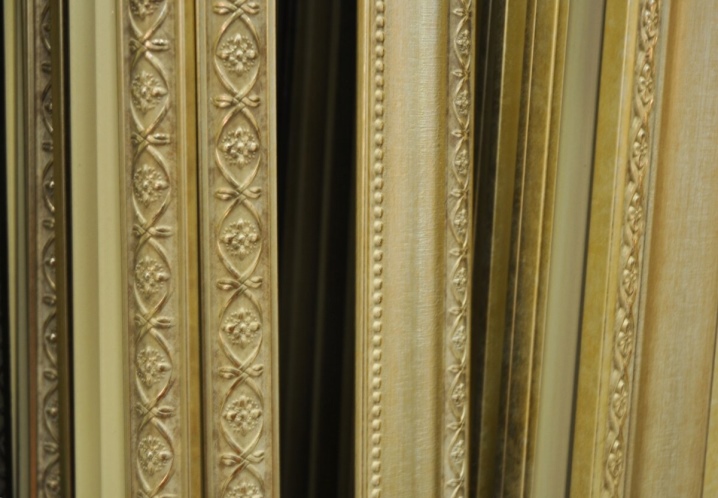
Location options
The location of the wallpaper border depends on the chosen design, as well as on the features of the room perspective and the function of the tape. Based on this, the wallpaper tape can be positioned in different ways. The location can be not only horizontal, but also vertical.
- At the top of the wall. For example, at the ceiling along one of the walls, creating a decorative border between the ceiling and the wall.

- Above the perimeter of the ceiling. Thus, the zoning of the room or the division of space is performed.
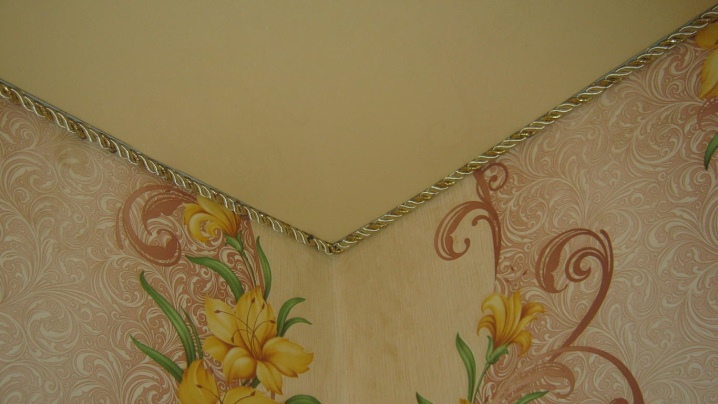
- In the middle of the wall, highlighting a specific accent area or masking the joints of different wall materials. However, experts do not recommend resorting to such a solution unnecessarily.
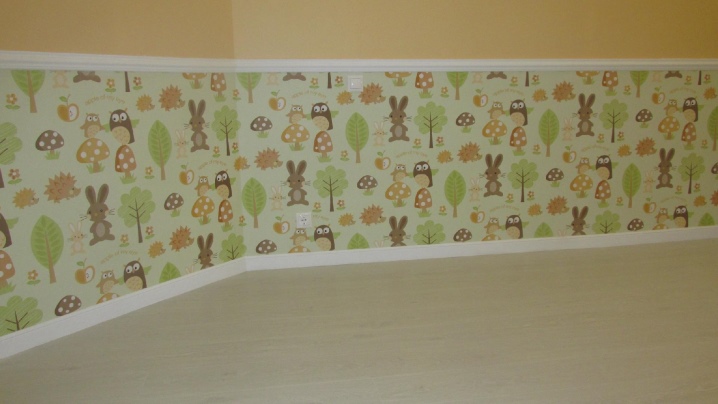
- In the lower third of the wall surface. The implementation of this technique smooths out the difference between the shades of the selected wallpaper.
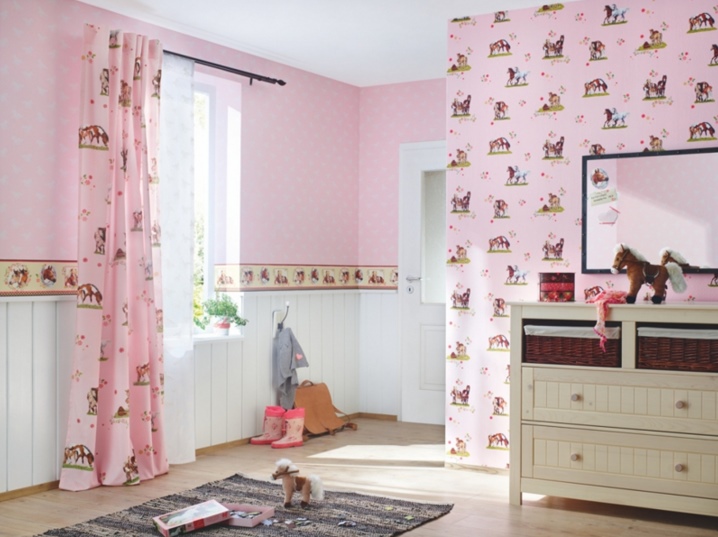
- Downstairs, almost at the very floor, securing the bottom edge of the wallpaper and hiding the flaws of their gluing.
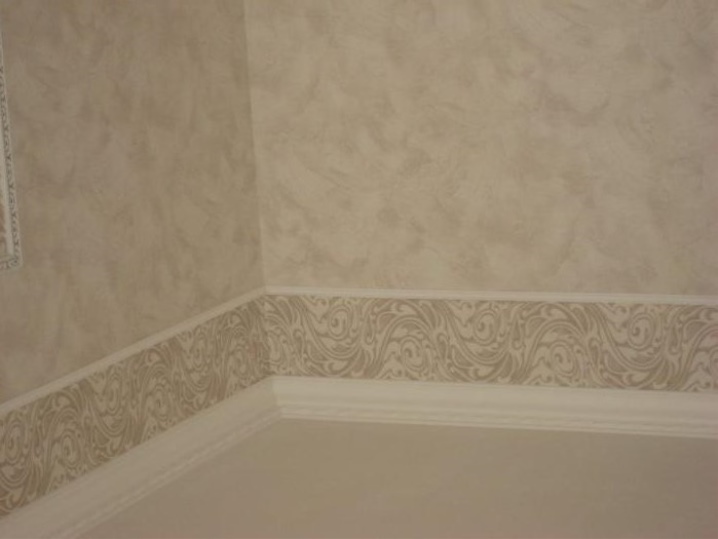
- In several vertical rows. In this case, the stripes can be located both at the same and at different distances from each other.
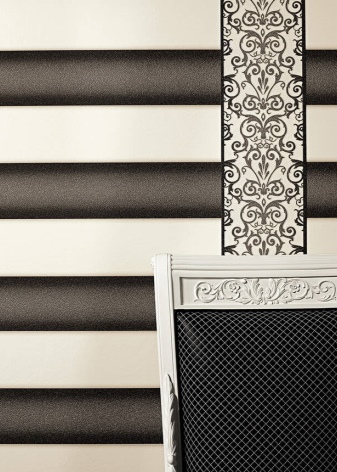

Besides, border tape is used to accentuate wallpaper glued like a panel. This technique creates a unique design for wall accents. Vertical stripes can decorate the walls along their entire height. Thus, you can beat the joining of two wallpapers of different colors on one wall. The strips can also be glued over the floor plinth.

Besides, with a wallpaper border accentuate the places of pasting wallpaper around doors, windows and mirrors. However, in these cases, a professional approach to decorating is required. Otherwise, the wall decor loses its attractiveness and only overloads the space in the interior.
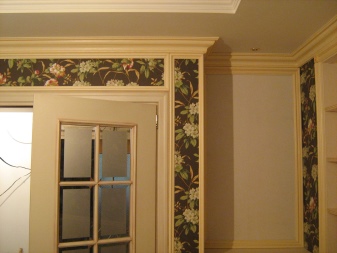
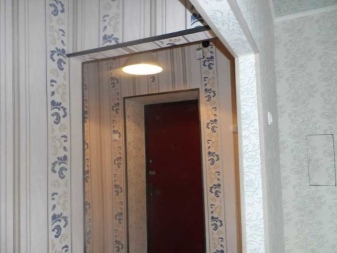
How to glue the border?
The gluing of any border depends on its type. For example, if the wallpaper is thin, you need to glue the stripes on them. The butt trim is only glued when working with thick (vinyl) wallpaper or two-layer embossed versions.
If the wallpaper has a deep relief, the border tapes are glued to the walls, leaving areas of the required width for them.
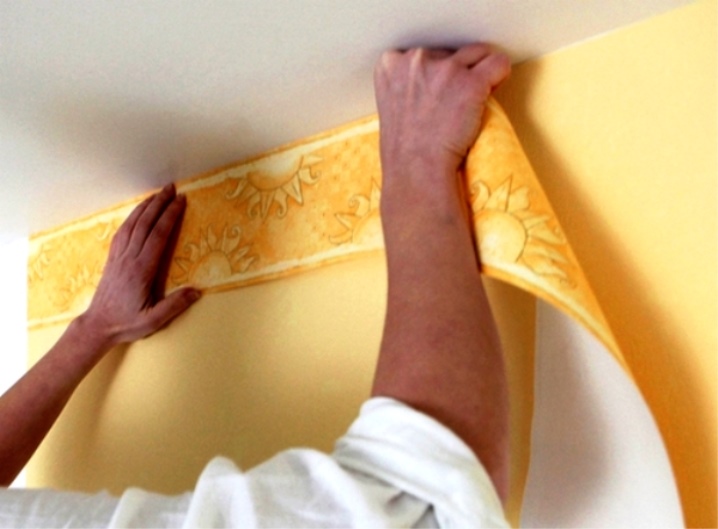
The tapes are glued exclusively on a dry and clean surface. If the wallpaper is just pasted on, it should dry out. Stripes with a pattern are tried to be cut in such a way as to achieve a match of the print. In work, you can use a plastic spatula, a soft sponge or a roller to smooth the tape. Depending on the type of tape, you will need to prepare an absorbent cloth, a knife to cut off excess material, and a glue brush.
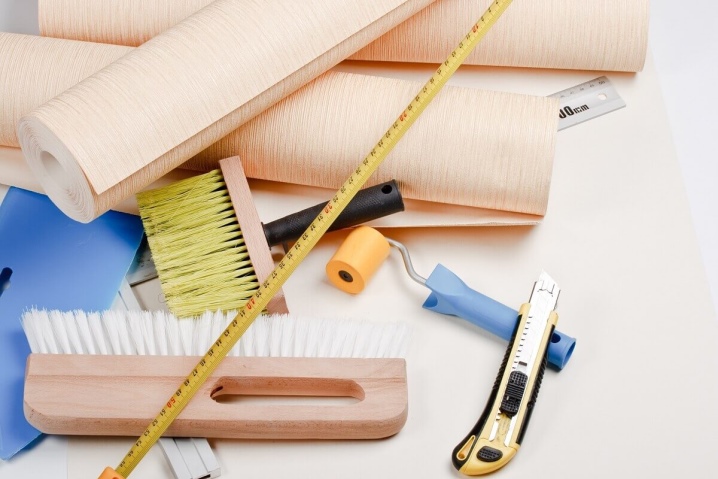
Self-adhesive tapes are some of the easiest to use. To glue them evenly, markings are made. Further, it is enough to remove the paper backing and attach them to the wall, setting the correct direction and avoiding the formation of bubbles.
The only difficulty can arise if the wallpaper is not glued to the aligned walls. Therefore, the substrate is not completely removed, but the strip itself is smoothed out immediately as it is glued.
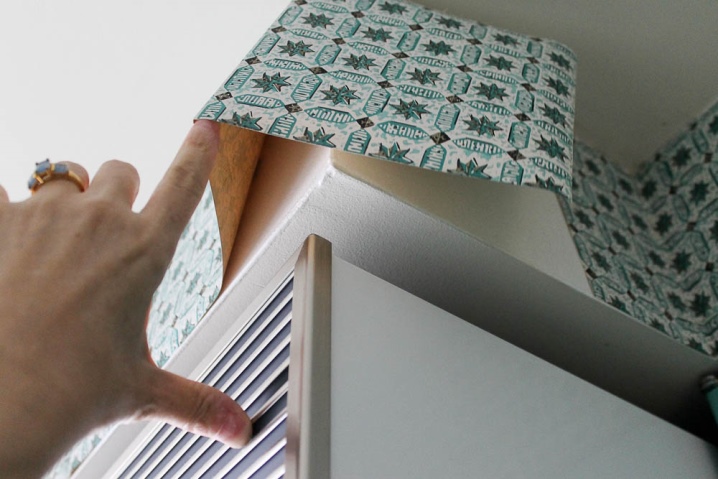
The glue-based edging must be moistened with water before gluing, and then pressed to the gluing site. You need to cut the strips with a margin so that they are wrapped at corners of at least 3-5 cm.If it is necessary to combine them vertically (for example, when decorating a rectangular panel), this should be done at an angle of 45 degrees.

Ordinary strips of vinyl, non-woven or paper are glued to wallpaper glue. The technology of working with them does not differ from pasting walls with wallpaper. Glue is applied to their base from the back side, left for 5 minutes, after which the strips are attached to the selected place according to the prepared markings. When gluing in the corners, the friezes must be overlapped.
If the tape is too long, it can be cut into 1.5 m pieces. Professionals don't cut strips. Do not stretch the tapes and bend them, they can break from this. Excess glue is removed with a rag, rolled over the surface with a roller, eliminating air bubbles. The tapes usually dry out within a day.
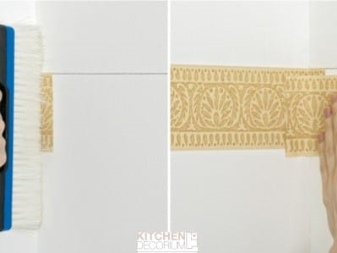
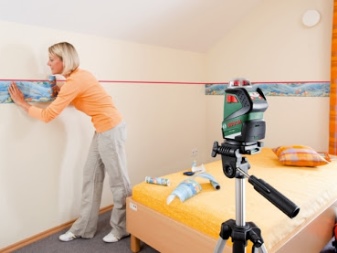
In the next video, you can visually familiarize yourself with how to properly glue the borders for wallpaper.













The comment was sent successfully.